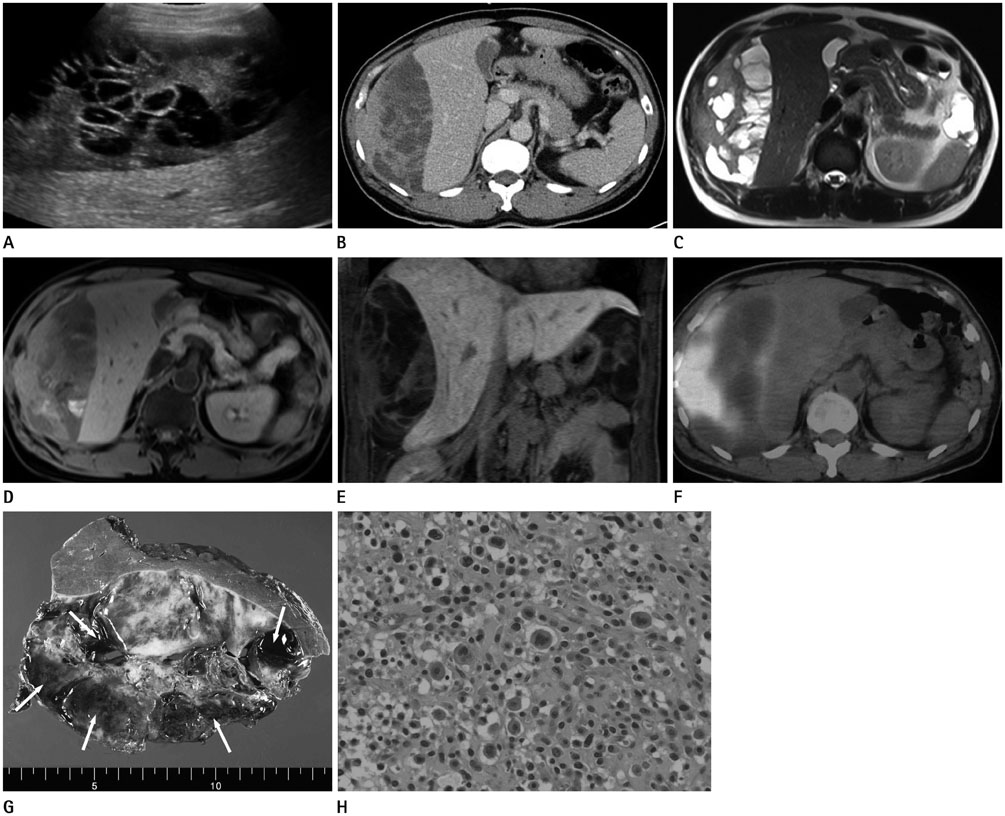J Korean Soc Radiol.
2015 Jul;73(1):49-52. 10.3348/jksr.2015.73.1.49.
Primary Undifferentiated High-Grade Pleomorphic Sarcoma in the Perihepatic Space: A Report of a Case
- Affiliations
-
- 1Department of Radiology, Daegu Fatima Hospital, Daegu, Korea. nosmokeman@naver.com
- KMID: 1823923
- DOI: http://doi.org/10.3348/jksr.2015.73.1.49
Abstract
- Undifferentiated high-grade pleomorphic sarcoma (UPS) is a pleomorphic soft tissue sarcoma derived from histiocytes capable of fibroblastic transformation. UPS affects soft tissues of the body, especially the extremities and retroperitoneum, and primary UPS in the perihepatic space is extremely rare. We report a case of primary perihepatic UPS in a 44-year-old male, who presented with fever and right upper abdominal discomfort.
MeSH Terms
Figure
Reference
-
1. O'Brien JE, Stout AP. Malignant fibrous xanthomas. Cancer. 1964; 17:1445–1455.2. Fletcher CDM. So-called fibrohistiocytic tumours. In : Fletcher CDM, Unni KK, Mertens F, editors. World Health Organization Classification of Tumours. Pathology and Genetics of Tumours of Soft Tissue and Bone. Lyon: IARC Press;2002. p. 120–125.3. Atmatzidis KS, Pavlidis TE, Galanis IN, Papaziogas BT, Papaziogas TB. Malignant fibrous histiocytoma of the abdominal cavity: report of a case. Surg Today. 2003; 33:794–796.4. Park JH, Yeon JW, Han EM, Jang SK, Kang SM, Ahn IO. Primary malignant fibrous histiocytoma of the mesentery: a case report. J Korean Radiol Soc. 2007; 57:549–552.5. Kweon JH, Choi CS, Im CJ, Seo GS, Choi SC. Malignant fibrous histiocytoma arising from the omentum presenting as hemoperitoneum. Gut Liver. 2010; 4:241–244.6. Yun YC, Jun KH, Jung JH, Chin HM, Chun CS. Malignant fibrous histiocytoma originating in the lesser sac. J Korean Surg Soc. 2005; 68:505–508.7. Karki B, Xu YK, Wu YK, Zhang WW. Primary malignant fibrous histiocytoma of the abdominal cavity: CT findings and pathological correlation. World J Radiol. 2012; 4:151–158.8. Goldman SM, Hartman DS, Weiss SW. The varied radiographic manifestations of retroperitoneal malignant fibrous histiocytoma revealed through 27 cases. J Urol. 1986; 135:33–38.9. Chen HC, Chen CJ, Jeng CM, Yang CM. Malignant fibrous histiocytoma presenting as hemoperitoneum mimicking hepatocellular carcinoma rupture. World J Gastroenterol. 2007; 13:6441–6443.
- Full Text Links
- Actions
-
Cited
- CITED
-
- Close
- Share
- Similar articles
-
- A Case of Pleomorphic Dermal Sarcoma Showing Characteristics of Myxoinflammatory Fibroblastic Sarcoma
- Cutaneous Metastatic Undifferentiated Pleomorphic Sarcoma from a Mediastinal Sarcoma
- Sinonasal Undifferentiated Pleomorphic Sarcoma in Five Patient Cases
- Primary Undifferentiated Pleomorphic Sarcoma of the Left Atrium that Presented as Acute Pulmonary Edema
- Primary Undifferentiated Pleomorphic Sarcoma of the Colon Mesentery


